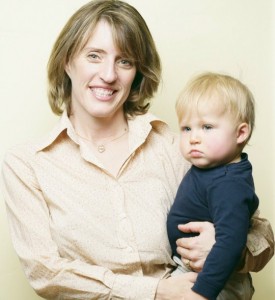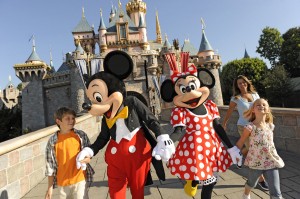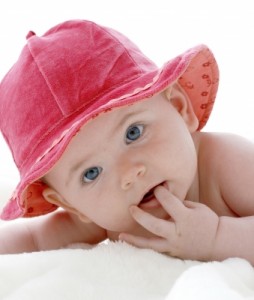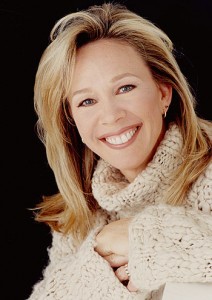As a wife, mother and life coach, Amy Kovarick is a master of multitasking, and she’s helping others find balance in their lives, too.
By Leslie Dinaberg
Wife, mother, life coach, counseling psychologist, radio host and author of Baby on Board: Becoming a Mother Without Losing Yourself, Carpinteria-based Amy Kovarick knows a lot about multi-tasking.
Leslie Dinaberg: So you got started as a life coach after leaving the corporate world?
Amy Kovarick: Yes. I got married at 39 and Matt was born when I was 40, so it was a tremendous change. And finding where the ambitious kind of career Amy fit now with all of these other hats was part of my journey. One company I have, Empowered Motherhood, (Empoweredmotherhood.com) is very much about that. How do you keep close to yourself and true to who you are and yet bring your best to your kids?
… that’s kind of the heart of coaching, whether it’s Empowered Motherhood where it’s a mother community … or my private coaching practice (Amykcoaching.com) where I work with people across the country. The coaching part, no matter who I’m working with, is looking at that balance across your life.
… I’ve got folks who come for career issues, relationship issues, health issues, really right across the board. But it always comes down to balance, which one is falling off the load and have you even stopped to think about where you fit in and what you want, what’s interesting to you nowadays?
LD: It sounds like we could all use some of that.
AK: (Laughs) I think the best coaches are the ones that truly believe they don’t have answers for someone. They think you know deep down inside what’s best for your life and are good at just bringing out who you are. But the tricky part or the tough part about coaching is that there’s all that self-reflection and kind of the touchy feely part, coupled with a bunch of accountability and action items. That’s what drew me to coaching was the combination of the soft side with the no nonsense lets move side.
LD: What kinds of people typically come to you?
AK: A good example is the owner of this restaurant (Corktree Cellars in Carpinteria). She didn’t need to be fixed, she didn’t have a problem, she had a goal … I’ve worked with a lot of entrepreneurs, both men and women and a bunch of executives. I do corporate contracts where the corporation is paying me to coach some of their top leadership in reaching their peak performance if you will. But what I love about that is it is still the same, it’s one on one, there’s nobody there on the phone but them and I’m not working with their board of directors or their boss, it’s still weaves in issues from across their life.
I have a new woman that took on her first president role and so she’s been VP, she’s been this and that, but she’s a mom, she’s got two kids and she’s got all of the issues with that, plus she’s a new female president, in a new company that she doesn’t know these people, a bunch of men that are working for her and reporting to her and the coaching with her is full of all of the things you would imagine.
There are a lot of practical business things but there is the okay, how do you show up and be your full self and be as bold as you want to be and don’t be afraid of stepping on toes, but yet be effective. That’s what I love about my work.
One of my favorite long-term clients was a young girl going through college in New York and her father was footing the bill because he wanted her to be very successful. There’s a different kind of pace of just really working through her journey of becoming an adult and she’s graduated and is down in Australia at the Great Barrier Reef, she’s a conservation biologist.
… So the dreams differ, one wants to be the best leader, one wants to open a restaurant, one wants to be a marine biologist, so it sounds very different, different ages and walks of life, but it is all the same thing of who are you, what do you want to do, how are you going to get there–and that’s what fascinates me. That’s what keeps me in it is every person is different and no two coaching sessions look alike.
LD: In a way it sounds like what writing does, you sort of get to live other lives because you’re finding out so much about what other people are doing.
AK: Yes. And I get I thrive on one on one, real conversations, not a lot of superficial stuff. I’m terrible at networking or parties where you have to just chitchat. That’s my worst thing. So when I get to do my coaching, these people share a lot. And they come pretty unguarded, even my tough male executives.
LD: Do you get people that are motivated to change something?
AK: Yes. Change, grow. It’s people who even though they all look so different on the surface, the common thread is this desire to grow, to not just be successful because it’s not always about people wanting monetary success, it’s this almost fierce desire to not be static, to not stay the status quo. They want to keep pushing out their barriers, and some people for sure come with a problem, come with I’m really unhappy at work, I’m really unhappy in my relationship, I would like to meet someone, I would like to lose 50 pounds. Sometimes there is a very specific problem and they are all willing to look at themselves to take responsibility. By the nature of no one is going to hire me and pay my fees if they are a victim. … People who show up and want to work with me, they’re serious about their life.
… Often I get asked, well how is this different than therapy … the big difference is therapy often is about healing or fixing and it often goes into the past and the whys. How did I get here? Whereas coaching is about where are you now. Coaching is much more about present and future and very seldom do I go to the whys or what happened with your parents. That’s just not part of the conversation even though that’s really valuable but it’s not what I do.
LD: If you could be invisible anywhere in Santa Barbara, where would you go and what would you do?
AK: If I could get into my husband’s head. He’s a very private guy and as he said last night, “you know more about me than anyone in my entire life has every known.” But it’s like pulling teeth.
Vital Stats: Amy Kovarick
Born: Newport, Rhode Island, April 23
Family: Husband Mike Musson; Stepdaughters Layla, 20; Fina, 18 ; and Meli, 15; and son Matt, 2-1/2.
Professional Accomplishments: Author of “The Empowered Mother,” host of the radio show “Empowered Mother,” MA in Counseling Psychology, PCC (Professional Coach Credential), member of the International Coach Federation, has worked with hundreds of people in North America helping them reach their dreams.
Best Book You’ve Read Recently: Age of Turbulence, by Allen Greenspan
Little-Known Fact: I was in the Air Force and worked at the Pentagon.





